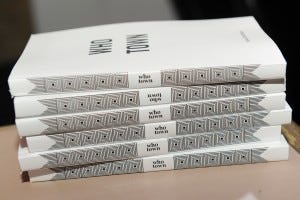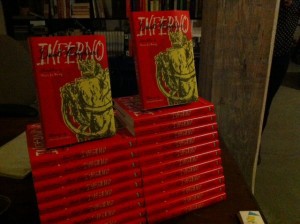Craft
Diary of A Rogue Writer, Part One: The path to self-publishing
Ph

Photo by Phyllis Leibowitz
I landed in New York City in the late 90s, armed with a Bachelor of Science in International Area Studies from Drexel University, myriad hours logged at cafes tripping around Europe as a stagaire (i.e. unpaid researcher) at the European Parliament, and a recommendation letter from Philadelphia Magazine, after a short gig there. I had earned proficiencies in French and Italian, a main component of my IAS degree. But I refused to sign a contract dictating that I never wear lipstick for a post college job at Euro Disney. The job would have taken me back to Paris, where I could have eventually fulfilled my dream of an expat writer’s life. Instead, I fell into journalism in NYC, penning profiles and trend stories about other people because I was too afraid to create my own stories — until the nightmares started.
Books had always played a major role in my life. It began in my nursery days, with mom and dad reading me stories before bed each night; through gold medals earned at the local library’s youth reading club; to the journals of poetry and rolling prose I penned, hoping to mimic favorite authors. Books and my own scribbled histories felt like actual living entities, like friends. In my seventh year as a journalist, I started waking up in the middle of the night with phrases and characters running through my head: the “petit rat” or skinny woman who had taken up with an ex boyfriend and was eating him alive, literally. A neighbor’s dead dog whose ghost circled the block barking for a decent burial. A unicorn that flew into a den of junkies.
I started jotting them down on scraps of paper and copying them into a composition book the following day. Eventually, I just slept with the notebook tucked under my mattress. This was the beginning of Who Town, the novel I self published through Create Space/Amazon in May.
Who Town — a tale of a group of twenty somethings coming of age in the eye of the trend media, and fighting

Susan Kirschbaum (Photo: BFA agency)
their own truths/souls in the process — was directly inspired by my real-life experiences writing for The New York Times, and the late night adventures post-assignment. But it took five years to mold it into something cohesive from my vivid dream notebook. It survived many lifetimes as a manuscript (including an initial draft entitled “A Beautiful Madness”), meaningful critiques from a literary author/professor and another from an esteemed documentary filmmaker/book addict, collaborating with an editor at Bloomsbury, and twenty-five agent queries, before I capitulated and published it myself. (I did procure the agent; more on this to come.)
While I did not join any writers’ workshops, I did seek guidance and feedback, which is a vital part of the process. I carefully decided who I’d allow to read my drafts. About a sketch draft, an author friend told me, “You need to vomit on the page. You need to dig deep into the vein. Bleed.” The recipient of the subsequent fattened yet chaotic draft was the novelist Rene Steinke, nominated for the 2005 National Book Award for Holy Skirts.
I had met Steinke at a mutual friend’s book reading. She had some time on her hands and, luckily for me, offered to read my work. She compared me to the French writer Colette because of my attention to social underpinnings and visual detail. I still have her notes, which started with, “While there are some things you need to change, this kept me interested in reading until the end, which is A BIG THING.” She advised me to change the perspective from the omniscient narrator to close third person, with the narrator changing every few chapters. I found it much easier to manage, and it helped me “kill off” extraneous darlings that were detracting from the tale.
My second professional critic — a documentary filmmaker who also wrote witty screenplays — read “A Beautiful Madness” around the same time. A close personal friend, he proved much less impartial. He sketched the word GENIUS in the margins a few times. But he also drew an “X” on the front of my manuscript and wrote in red ink, “TERRIBLE TITLE.” In the same week he had handed me back his notes, we shared a taxi and started throwing around ideas. “It’s a book about who’s who…” He started. “Yes! I need to have who in there…” I remembered the wonderful Dr. Seuss and his Whoville. “Who Town!” I shouted. My director friend clapped his hands. “Who Town! That’s genius!”

With the improved title, I got to work on a third draft that I sent out to agents I had found in guides, but also to some recommended by literary folks I had known from New York publishing cliques. I will admit that my byline from The Times — even as a contracted freelancer — helped to open doors, but not enough to secure me a deal with a house. After collaborating with a former editor at Bloomsbury who moonlighted as a book doctor for a fee, I found representation at Sterling Lord Literistic. My agent asked me to sign with him for two years but I committed to one and a half, during which time we got feedback — mostly “too dark” or “too literary.” My agent began prodding me to acquiesce to more commercial interests given my glamor journalism background, maybe write a book about fashion. Ergo, the death knell: I could not walk backwards after writing Who Town. So we parted and I shelved my first child for a couple of years.
I continued to pen stories for magazines and branched into editing web stories to pay the rent. In this intervening period — inspired by Philip Roth, Vladimir Nabokov, and my eccentric late grandmother, Eva — I wrote a second novel called Cherry Picker, about a nebbish 33-year-old Jewish filmmaker obsessed with marrying a shiska (non-Jewish) virgin bride. I sent it to agents, who with the arrival of the Kindle and what I’ll call the boon in sensationalist memoirs and celebrity books, seemed warier then ever. Again, my rejections featured phrases like “too dark” and “too risky.”
My friend Ira Silverberg, once the Editor-in-Chief of Grove Atlantic Press (and also a former literary agent), was on the cusp of leaving the business. Dismayed that publishing houses were not buying enough work from gifted authors, he took a post as Literary Director of the National Endowment of the Arts in Washington, D.C. He read my first ten chapters of Cherry and wrote, “The characters are developing beautifully. I get the feeling THIS IS IT!” When I asked him for last words of advice, he emphatically stated, “Self publish. If I wrote a book now, that’s what I would do.”
The idea of self-publishing always smelled of amateurs, folks who considered themselves closeted Pulitzer contenders, delusional charlatans, anti-establishment but not in a positive way: rejects of the intelligentsia. I began to obsessively visit Barnes & Noble. Noting what lined the front shelves (chick-lit, “autobiographies” of reality TV stars), I pondered just how far hype had obscured the great literary tradition in which I wanted to engage. Ira’s advice still haunted me. “Self publish.”
So, I did.
***
Read part 2 here.
***
— Susan Kirschbaum lives in downtown Manhattan. Her first novel, Who Town, is now selling at selected New York City bookstores (including McNally Jackson) and on Amazon. She will be speaking on a Self-Publishing Fiction panel on November 1 at Spoonbill & Sugartown at 7:30 pm with Maggie Craig, Nathaniel Kressen, and Rami Shamir.









